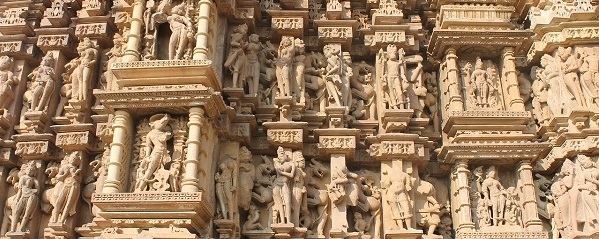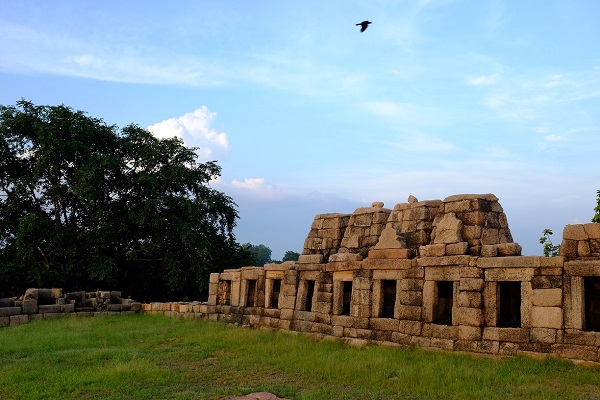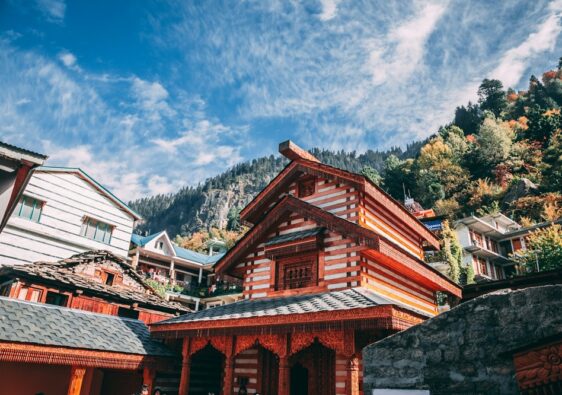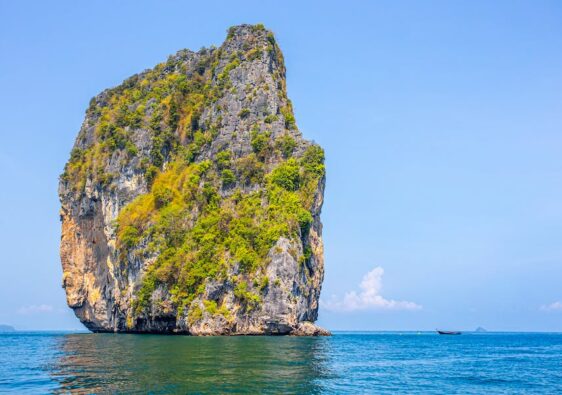Khajuraho is a place with outstanding artistic structures and a unique history that unfolds right from the moment you head on through the streets and temples of the city. I have been to this mystical land – twice and learned about who built the Khajuraho Temples, why they were built and the history of the infamous erotic nature of them.

Today’s blog post is about this beautiful city in the land of nature that Madhya Pradesh is. I’d advise you to fasten your seatbelts – since we are going on a time travelling adventure!
BOOP!
And here we are! 8th – 10th century!
Table of Contents
History of Khajuraho? Who built the Khajuraho Temples?
We enter into a city unknown to the world and most of the country – a city full of khajur (dates), a city aptly named Khajuravahaka (A carrier of dates).
This place can’t even be called out as the modern meaning of a city, it’s basically a tribal village which belongs to The Gonds (the face of Indian Tribal and the largest group of aboriginals) – covered with dense forests and sounds of wild creatures.

We go a little further in time and we see kingdoms being made around this place. We see centuries passing by, dynasties changing and kingdoms getting destroyed and conquered once and again – from Vatsa to Mauryans to Shungas to Kushans to Bharshiva to Guptas and furthermore to the Chandelas.
As per the history, there were about 85 temples built with these carvings out of which only 25 remain now.
So the basic and direct answer to the question Who built the Khajuraho Temples is The Chandela Dynasty. Loud and Clear.
As we enter the 9th century, we see that the rulers of Chandela spread out from Bundelkhand towards this place. They setup their kingdom their. This is the time when the art of the area gets noticed.
This is – where the history of Khajuraho temples – Begin!
The Moon Child and a Prophecy
Before heading into the history of how the temples were built, let’s go deeper into the history of who built the khajuraho temples – The Chandelas.
So we head deeper into the history of the kingdom and find ourselves in Banaras – on a beautiful and magnificent night.
We see a women who seems to be made up of stars and twinkles and rose petals – a beautiful girl named Hemavati.

That night she looked like magic while swimming and bathing in a natural pool – that’s when someone caught her beauty in his eyes. This someone was not a human, neither a wild creature – but a God. Specifically, the Moon God!
The Moon God got mesmerized by her splendid gorgeousness and could not help but come down towards the surface. He made his presence known to Hemavati and told her that he’s fallen for her – with all it’s eight phases (to himself and back – if you will :P)
The Moon God himself was well, a God – and looked immensely beautiful as well. Hemavati accepted his feelings and that night – A God and a Human made love – and the entire universe skipped a heartbeat!
But can love happen without consequences? Highly unlikely!

The Moon God had to return to his place on the sky – or the world would fall apart. And since Hemavati got pregnant she had the entire society to answer. The Moon God then held her close to him and prophesied that – “she shall head on towards an orchard full of date palms, where their boy will enter the world and construct temples with erotic sculptures depicting the passion, love and desire that exists in the universe“. This orchard – was Khajuraho.
As per the prophecy, Hemavati left her home with a child inside her and left for Khajuraho. Once there, she began a sacred ceremony of constructing erotic statues and temples as a way to take it all head on and to make the later generations who get to watch these structures – liberate the women from the stigma of a love affair!
The child, named Chandravarman, was born with divine strength and grew up to be the first ruler of the Chandela Dynasty.
History of the Khajuraho Temples
After Hemavati passed away, it is believed that she came into a dream of her son and asked him to create temples around the city depicting human passions!

Chandravarman started constructing huge temples around the city carrying forward the prophecy of his father and to cleanse his mother from all negativities that society would throw at her or any women from the future.
As we move further a couple years since Chandravarman built the structures – we see many Chandela rulers building temples and taking forward the legend of their kingdom’s origin. It quickly became a tradition for all the upcoming rulers to construct temples depicting lifestyle of men and women observed during their era.
Most of the temples were built in Sandstone with a Chandela style architecture (a man with a lion) and Nagara-style of construction built upon granite foundations. All temples followed the Hindu temples design structure of Vastu-Purusha-Mandala.
First Mentions
The Chandelas ruled the Central parts of India for centuries and the constructions went on. It was later in 1022 AD that a Persian historian named Abu Rihan-al-Biruni accompanied Mahmud of Ghazni – who came to raid through the city. The raid was unsuccessful and the Turkish ruler agreed upon a peace accord after the Hindu king gave him a little ransom amount.
The historian took his chance and that accounted for the first ever mention of the Khajuraho Temples ever recorded in history.
A century later – Ibn-e-Battuta mentioned Khajuraho temples in his memoirs about his stay in India.
Turning to Ruins
Then came the Muslim dynasties and the Turkish rulers! The central part of India started to slowly come under the rule of Mughals since 13th century and went on till 18th century! During this time, many temples including several from Khajuraho itself were destroyed and desecrated. What remained of them is ruins.

Although, they couldn’t destroy all of the temples due to the fact that Khajuraho was isolated from the larger cities by being in the wild. The nature, the wilderness and the greenery saved these monuments so that the legend of the temples remain intact till eternity.
Lastly, during the British era, the local Hindus guided a British surveyor called T.S. Burt to these temples – and he got mesmerized by the art, the structure, and the life that the temples displayed. That is when the Khajuraho group of temples became globally known.
In the 20th century, the temples were rediscovered and preserved and also became a member of the UNESCO World Heritage Sites.
Calm in the Chaos
Coming back to the future – the temples of Khajuraho that we see today depict only 10% sexual desires or passions of a human being. The major part of all temples showcases the entire life cycle of the people who lived their, the kingdom, even the animals. The temples depicts images from childhood, household tasks of men and women, hunting, horses and elephants, war, sex, passion and death.

You can see musicians composing, women applying makeup, activities of pottering, farming, etc. Other than the human beings, the temples also showcases many smritis of Shiva-Parvati and other deities along with male and female principles.
These act still as a learning for various generations to come and look at the history and the culture and understand their own desires and the value of life.
Looking at those epic arts over different temples throughout the city makes us understand that the locals back more than centuries ago weren’t too different from us.
The local guides will tell you and you can see in the way they tell it that they’re not lying about it – that the temples were built during a time when humans were about 8ft tall and it was pretty easier to carve out the structure with daily observations.

It is also believed that one of the reasons of creating the sexual Kamasutra-esque figures was that when the wars were fought – they would ruin everything from physical bodies to mental health of the kingdom. Many were killed and butchered and chaos erupted no matter who lost or won – people always suffered.
To tackle the issue and to make people channel their desires and to enrich their lives with love and passion – the king decided to make such images of sexual activities of all kinds onto the walls of the large temples so people could see that – think about it – and have fun! (or to just feel the sense of a calm-in-the-chaos moment). Also, it was done to increase the population of the entire kingdom.
Conclusion

And we come back to today – and the time travel journey drops us at our own places – with the knowledge of a legendary story about a legendary place with legendary people and a legendary tale!
I hope this gets you excited and I can’t say this enough – “Khajuraho is worth your visit!” So when you do – do not forget to tell us in the comments whether you liked it or no!
If you liked today’s ride through the ages – Share this blog as much as possible so that the Ancient History of our nation spreads all over the place.
That’s All Folks!




